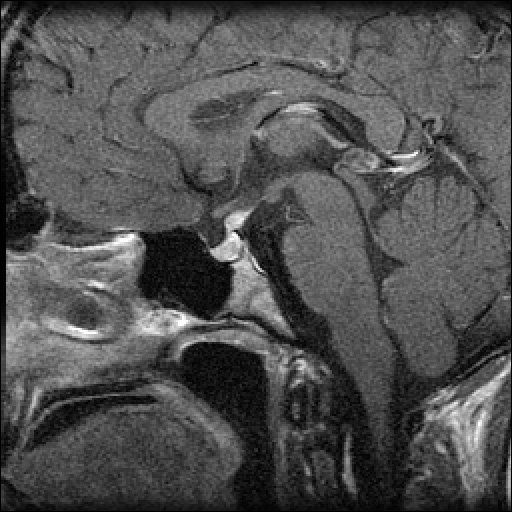An 18-year-old woman presented with a 2-month history of polyuria and polydipsia. She had been previously fit and well with regular periods. She was not taking any contraception.
Investigations:
serum potassium5.2 mmol/L (3.54.9)
serum corrected calcium2.30 mmol/L (2.202.60)
serum cortisol (09.00 h)350 nmol/L (200700)
She went on to have a water deprivation test, the results of which are detailed below. time (h)serum osmolality (mosmol/kg)urine osmolality (mosmol/kg) normal: 278300normal: 1001000
08.3028952
11.3029282
14.30301153
15.30-172
She was then given intramuscular DDAVP 2 micrograms at 16.00 h. time (h)serum osmolality (mosmol/kg)urine osmolality (mosmol/kg) normal: 278300normal: 1001000
16.30300-
17.30-530
18.30-532
Results from an MR scan of pituitary are shown (see image).

What is the most likely diagnosis?
- A. autoimmune (lymphocytic) hypophysitis
- B. craniopharyngioma
- C. non-functioning pituitary adenoma
- D. psychogenic polydipsia
- E. Rathke’s cleft cyst
Answer : A
An 18-year-old man with cystic fibrosis was referred to clinic. Over recent months his lung function had deteriorated and he had lost weight. He was being treated for a chest infection at the time of the consultation.
Investigations:
oral glucose tolerance test (75 g):
fasting plasma glucose8.2 mmol/L (3.06.0)
2-h plasma glucose13.5 mmol/L (<7.8)
What is the most appropriate management?
- A. repeat oral glucose tolerance test after chest infection has resolved
- B. restrict refined carbohydrate intake
- C. start gliclazide
- D. start insulin
- E. start sitagliptin
Answer : D
A 25-year-old woman presented at 28 weeks gestation after a screening 75-g oral glucose tolerance test, which had shown a fasting plasma glucose of 5.6 mmol/L (3.06.0) and a 2- h plasma glucose of 9.8 mmol/L (<7.8). She had a family history of type 2 diabetes mellitus and a pre-pregnancy body mass index of 36 kg/m2 (1825). Home blood glucose monitoring had shown persistently raised blood glucose despite dietary modification. She refused insulin because of needle phobia and was concerned about drug exposure to her unborn child.
The use of what hypoglycaemic therapy is acceptable in this situation?
- A. exenatide
- B. glibenclamide
- C. gliclazide
- D. pioglitazone
- E. sitagliptin
Answer : B
A 50-year-old man with a 9-year history of type 2 diabetes mellitus presented with excessive tiredness. His partner said that he snored excessively. His haemoglobin A1c was usually between 64 and 75 mmol/mol (2042). He was taking glimepiride 4 mg daily and orlistat. He was intolerant of metformin.
On examination, he had reduced sensation to a 10-g monofilament, and extensive background diabetic retinal changes. His Epworth sleepiness score was 13/24. His body mass index was 36 kg/m2 (1825) despite compliance with orlistat.
According to the NICE guidelines (CG87, May 2009), what is the most appropriate treatment?
- A. acarbose
- B. bariatric surgery
- C. basal bolus insulin
- D. dipeptidyl peptidase-4 inhibitor
- E. glucagon-like peptide-1 agonist
Answer : E
A 26-year-old man presented urgently, complaining of muscle pains. He had been found to have heterozygous familial hypercholesterolaemia 2 years previously owing to a mutation in the PCSK9 gene. He had a strong family history of premature vascular disease. He was taking atorvastatin 80 mg daily.
Investigations:
serum creatine kinase2782 U/L (24195)
serum cholesterol5.7 mmol/L (<5.2)
After stopping atorvastatin, his serum creatine kinase fell to within the normal range.
What is the most appropriate next step in management?
- A. restart atorvastatin 10 mg
- B. restart atorvastatin 40 mg
- C. start ezetimibe 10 mg
- D. start fenofibrate 100 mg
- E. start fluvastatin 40 mg
Answer : E

